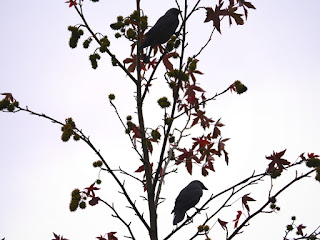A morning and early afternoon of rain, often heavy. It didn't deter the Long-Tailed Tits ...
... and I saw two flocks in different places within a few minutes of each other. I was never sure whether I was seeing different flocks or the same one several times, but now it's clear that there are at least two.
A Robin wasn't deterred by a raindrop bouncing off its face ...
... but a Jay looked quite bedraggled.
The male Peregrine was on the barracks tower. His face is much darker than the female's, and he almost always stands with his back to the view.
In the absence of the usual Grey Heron, Feral Pigeons perched in a row on the standing stone in the Dell.
A pair of Herring Gulls waved leaves at each other and moaned affectionately, and the female sat down in a significant way, as if nesting.
A Moorhen cruised through floating leaves.
A Greylag Goose drank from a muddy puddle. I can only assume that they like the taste of mud -- more interesting than plain water, like tea.
Shovellers fed at the Vista.
The Red-Crested Pochard in the Italian Garden added a bit of colour to a grey day.
The brood of four young Mute Swans on the Serpentine are now fully grown and absolutely enormous.
There was a hideous apparition in a hedge.
The rain slackened later and there was a brief dry spell which allowed a Cormorant to dry its wings ...
... and a weak sun came out for a moment, lighting up the beautiful markings of a female Gadwall.


























































